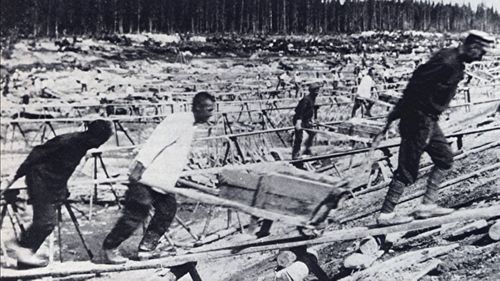The Soviet Gulag System: Unpleasant Details
Aug 08, 2023 · 2 mins read
0
Share

Alexandr Solzhenitsyn details how from 1928 the Soviet Gulag system was greatly expanded. Solovki camp, for instance, had in 1923 only around a thousand inmates. By 1930 there were 50,000.
Save
Share
The camps had once been a means to cleanse society of ‘doubtful’ people. Now it became a system of slave labor that was used for building large infrastructure projects including railroads and canals, and for logging, mining, and the opening up of remote territory.
Save
Share
The White Sea-Baltic Canal was constructed without any advanced machinery at all, just “zeks” (inmates) wielding picks and axes. It was completed ‘on time’ in 1933, but Solzhenitsyn’s estimate of the death toll is 250,000.
Save
Share
Between autumn 1938 and February 1939, 385 of the 550 prisoners at Ust-Vym camp died. In the autumn of 1941 the railroad camp Pechorlag counted 50,000 prisoners. By spring the following year there were only 10,000 (at no time were any prisoners transported out of the camp).
Save
Share
Inmates worked ridiculous hours, often in freezing conditions. The aim: get as much out of a prisoner before exhaustion, hunger or illness took their toll. Prisoners would eat dead, rotting horses, lubricating grease and tree moss just to have something in their stomachs.
Save
Share
In a chapter, ‘The History of Our Sewage Disposal System’ (The Gulag Archipelago) Solzhenitsyn provides the image of Stalin flushing millions of people down the drains and into the rivers of Russia, treated as nothing more than effluent.
Save
Share
The political "flushings" include the 1929-30 forced relocation of 15 million peasants and ‘kulaks’ (peasants who owned small properties) into the taiga and tundra. Large numbers died on the frozen wastes; not just men but whole families were sent.
Save
Share
From 1922 the Cheka secret police (originally the ‘Extraordinary Commission for Struggle against Counterrevolution, Sabotage and Speculation’) had begun cracking down on the Church as part of “the root destruction of religion in the country”.
Save
Share
Monks, nuns & priests, whose black habits had been a part of Russian life for centuries, were rounded up and sent to camps for a standard ‘tenner’ (10 years). Religious education became a criminal offense. The state’s shutdown of religion was mostly complete by the early 1930s.
Save
Share
0